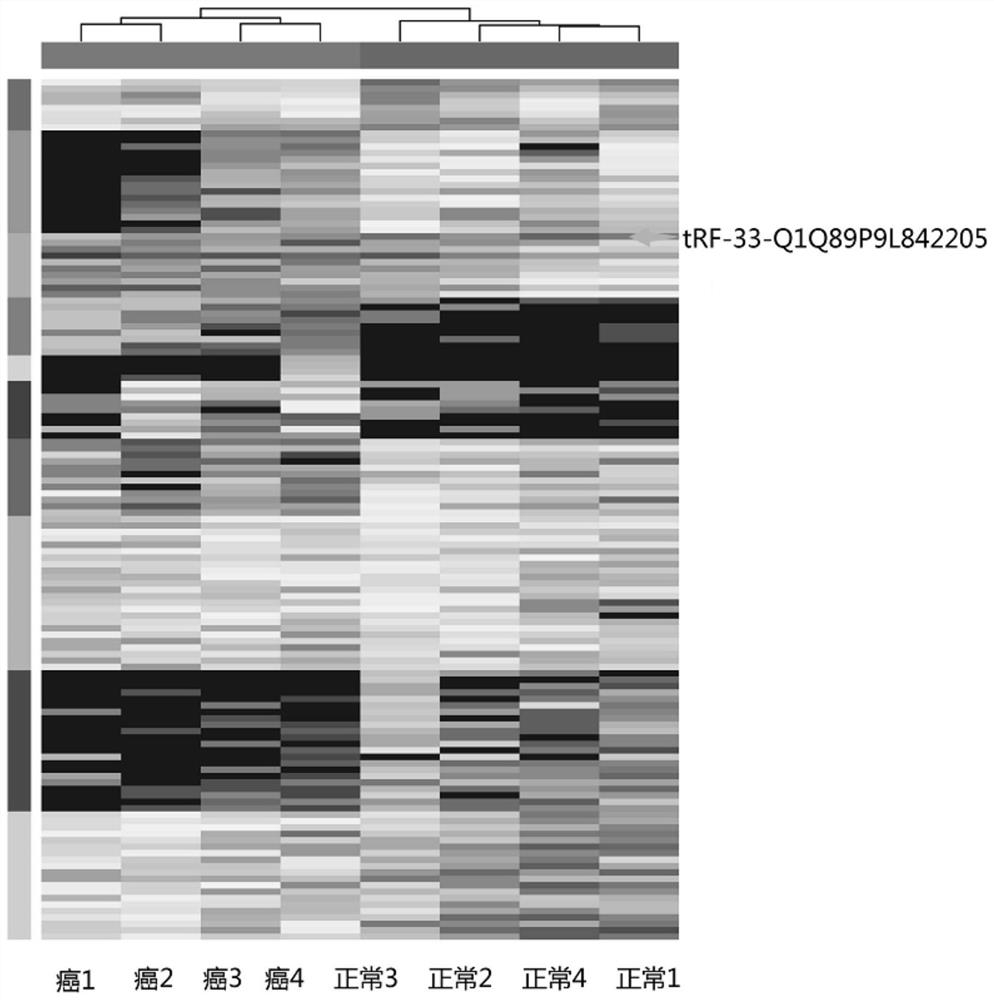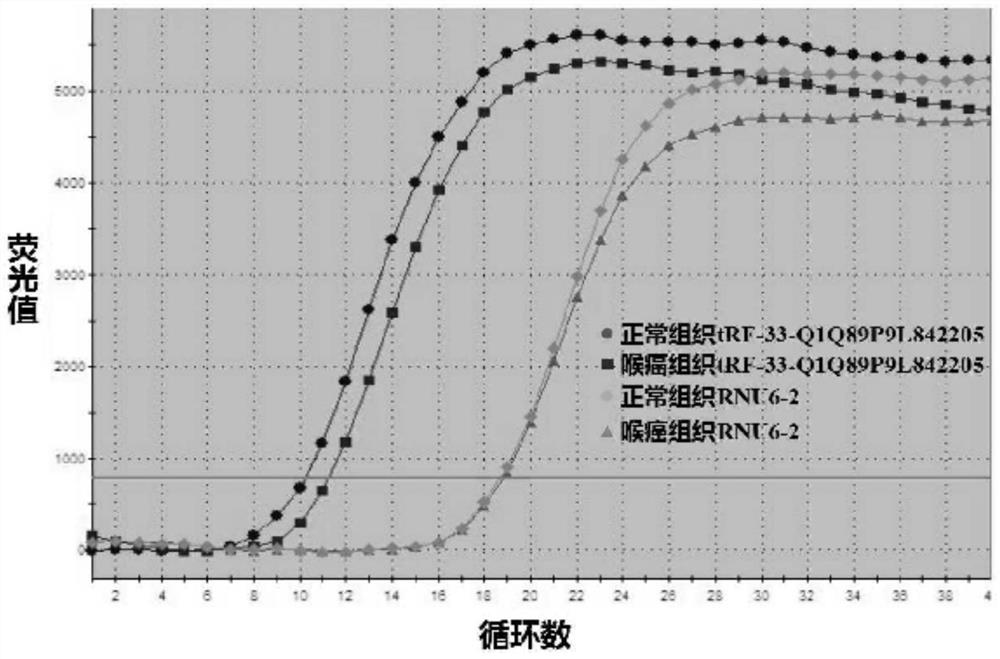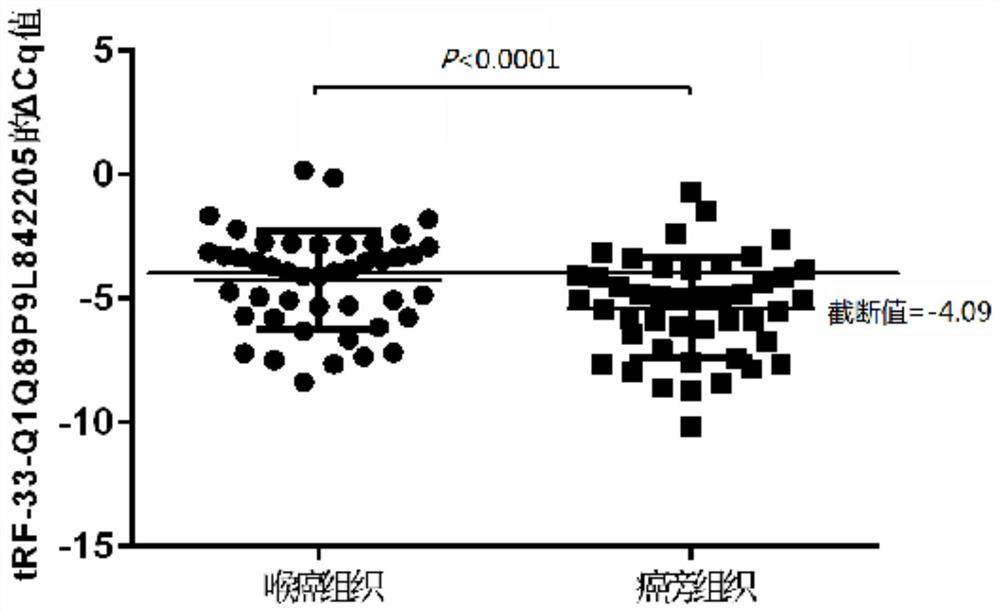Application of tRF expression primer in detection tissue in preparation of laryngeal cancer auxiliary diagnosis kit
A technology for auxiliary diagnosis and kits, which is applied in the fields of biochemical equipment and methods, and the determination/examination of microorganisms.
- Summary
- Abstract
- Description
- Claims
- Application Information
AI Technical Summary
Problems solved by technology
Method used
Image
Examples
Embodiment 1
[0035] To detect the expression of tRF-33-Q1Q89P9L842205 in laryngeal cancer tissue and normal laryngeal tissue:
[0036] Sequencing detection: The next-generation sequencing method was used to detect the level of tiRNA in laryngeal cancer tissues and normal tissues using tiRNA sequencing reagents from Arraystar in the United States.
[0037] Analysis of the results: the results are as follows figure 1 As shown, by analyzing laryngeal cancer tissues and adjacent tissues to obtain molecular markers expressing significantly down-regulated tRNA-derived fragments, tRF-33-Q1Q89P9L842205 was 2.94-fold different between laryngeal cancer tissues and normal tissues, as shown in figure 1 The arrows indicate that tRF-33-Q1Q89P9L842205 may function as a tumor suppressor gene in laryngeal cancer.
Embodiment 2
[0039] Collect normal laryngeal tissue as a normal control group, and perform tiRNA detection according to the following steps, including the following steps:
[0040] Step a. Collect laryngeal cancer tissue samples: Take 10-20 mg of laryngeal cancer tissue and immerse it in a nuclease-free centrifuge tube containing 1-2 mL of RNA preservation solution; if not used immediately, it should be stored in a -80°C ultra-low temperature refrigerator save;
[0041] Step b. Lysate tissue: Take the tissue in step a out of the -80°C refrigerator and thaw it at room temperature. After the RNA preservation solution is dried by filter paper, about 15 mg of tissue is cut from multiple sites and added to 1 mL of Trizol reagent in advance. In a 2mL nuclease-free centrifuge tube, use an electric homogenizer to fully grind the laryngeal cancer tissue into a homogenate, and incubate at 15-30°C for 10 minutes to completely dissociate the nucleic acid-protein complex;
[0042] Step c, chloroform e...
Embodiment 3
[0064] Method for detecting laryngeal cancer using tRF-33-Q1Q89P9L842205 biomarker
[0065] Steps include:
[0066] 1. Collect tissue samples;
[0067] 2. Extraction of RNA from laryngeal cancer tissue (extraction method is the same as in Example 2);
[0068] 3. The specific reverse transcription and fluorescent dye method qRT-PCR detection is performed as in the "specific reverse transcription and fluorescent dye method qRT-PCR detection" in Example 2;
[0069] 4. Using tRF-33-Q1Q89P9L842205 as a biomarker for detection of laryngeal cancer, the expression levels of tRF-33-Q1Q89P9L842205 in cancer tissues and adjacent tissues of 45 patients with laryngeal cancer were analyzed. The ΔCq of tRF-33-Q1Q89P9L842205 in the laryngeal cancer patient group was significantly higher than that in the normal group, P image 3 shown. The cut-off value of tRF-33-Q1Q89P9L842205 as a laryngeal cancer marker is -4.09. When the PCR relative quantitative value ΔCq of the tRF-33-Q1Q89P9L842205 bi...
PUM
| Property | Measurement | Unit |
|---|---|---|
| Sensitivity | aaaaa | aaaaa |
Abstract
Description
Claims
Application Information
 Login to View More
Login to View More - R&D
- Intellectual Property
- Life Sciences
- Materials
- Tech Scout
- Unparalleled Data Quality
- Higher Quality Content
- 60% Fewer Hallucinations
Browse by: Latest US Patents, China's latest patents, Technical Efficacy Thesaurus, Application Domain, Technology Topic, Popular Technical Reports.
© 2025 PatSnap. All rights reserved.Legal|Privacy policy|Modern Slavery Act Transparency Statement|Sitemap|About US| Contact US: help@patsnap.com



